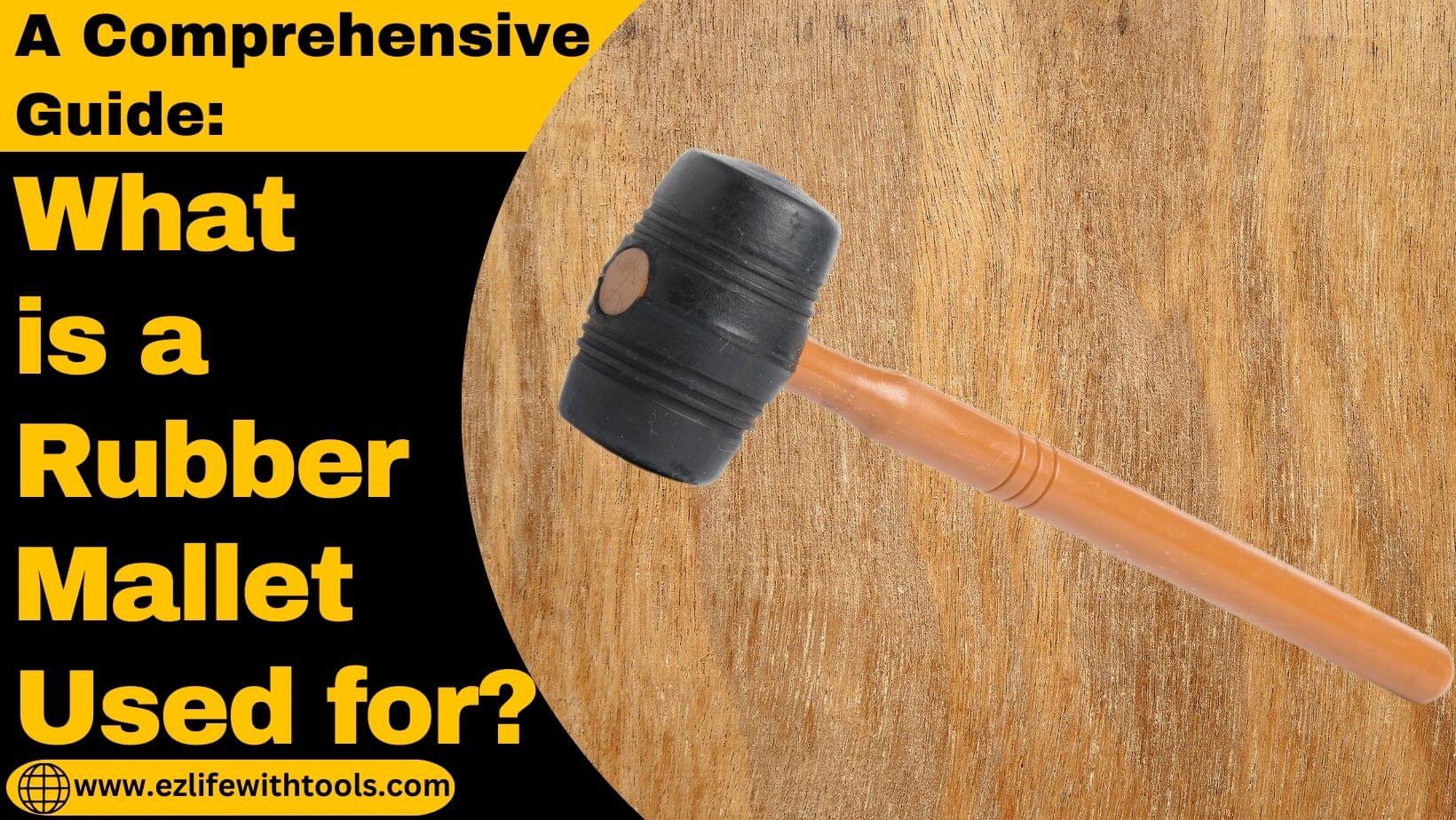A Comprehensive Guide: What is a Rubber Mallet Used for?
A rubber mallet is underestimated due to its simplicity; rubber mallets stand as unassuming yet indispensable

tools in the realms of construction, crafting, and various other industries.
Due to their unique properties, these specialized mallets have become invaluable assets in any toolkit.
Mallets generally have an ancient lineage, with historical evidence showcasing their use across cultures for tasks like woodworking, metalwork, and stone shaping.
The rubber mallet, a modern adaptation, integrates the advantages of rubber’s resilience and softness with the inherent functionality of a mallet.
Its design is straightforward yet effective. The rubber head’s varying size and hardness distinguishes it from other mallet types.
This adaptable tool finds its place in construction, carpentry, automotive work, crafting, and more, owing to its unique characteristics.
This article aims to delve into rubber mallets’ multifaceted applications and advantages, shedding light on their diverse uses across different fields and offering insights into why they are hailed as essential implements in numerous professional and DIY settings.
This article will have a significant impact on your career.
So, keep reading.
What is a Rubber Mallet?
A rubber mallet is a hand tool featuring a rubber head fixed atop a sturdy handle. It’s designed for tasks needing controlled force without damaging surfaces. The rubber head absorbs impact. It is ideal for setting tiles, adjusting furniture, or driving wooden pieces together, ensuring precision and preventing surface marks or dents.
Characteristics of a Rubber Mallet
Rubber mallets consist of a rubber head and a handle. The hardness of rubber can vary according to the type and need.
You can choose it according to the requirements of your industry projects because the choice of rubber affects the mallet’s impact and resilience.
It comes in different sizes and weights. Lighter mallets are suitable for delicate and small tasks that require precise and controlled impacts, while heavier mallets are suitable for projects that require greater force.
Moreover, it has variations in handle design, like straight, curved, or textured grips, to provide comfortable handling according to your preferences and specific project needs.
Types of Rubber Mallets
Rubber mallets have different types according to their construction and specific uses.
- Solid Rubber Mallets
- Two-Piece Rubber Mallets
- Soft/Hard Rubber Mallets
- Dead Blow Rubber Mallets
1- Solid Rubber Mallets
These types of mallets have a strong rubber head and are suitable for regular tasks like fixing furniture or working with wood.
2- Two-piece Rubber Mallets
They can be separated into two pieces, so if one part wears out, you can easily replace it with a new one to make it last longer.
3- Soft/Hard Rubber Mallets
The name shows its characteristics. Soft mallets are suitable for one’s soft and delicate jobs, while hard rubber mallets are for harder jobs which require a stronger hit.
4- Dead Blow Rubber Mallets
These mallets have a material inside which prevents them from bouncing too much. They are used a lot in fixing cars or working with metal.
What is a Rubber Mallet Used for?
Rubber mallets are multifunctional tools. It can be used in multiple industries to perform different tasks.
Here are some uses of rubber mallets.
- Automotive Applications
- Construction and Carpentry
- Crafts and DIY Projects
1- Automotive Applications
Bodywork and Dent Repair
In auto body repair, where precision is critical, rubber mallets help reshape metal panels or remove dents

without causing additional damage. The rubber head absorbs impact, making it ideal for shaping car body parts.
Damage-Free Component Installation
Whether installing trim pieces or delicate components, the rubber mallet’s soft yet powerful taps enable component installation without scratches or damage, ensuring a smooth fit.
2- Construction and Carpentry
Floor and Tile Installation
Rubber mallets serve as invaluable tools in flooring projects, facilitating the installation of tile, laminate, or

hardwood floors without damage. Soft rubber head allows precise tapping to set tiles or boards evenly in place.
Assembling Furniture
A rubber mallet is indispensable when assembling furniture, especially joints or parts requiring gentle persuasion. It helps the pieces assemble without leaving any bad marks or dents to ensure a professional finish.
3- Crafts and DIY Projects
Leatherwork and Jewelry Making
Crafts, especially leatherwork and jewelry making, require carefully handling delicate materials. Rubber mallets

help form and shape materials without leaving unwanted marks or marks.
Carving and Shaping Wood
Woodworkers and carvers often use rubber mallets to delicately tap chisels or carving tools while creating intricate designs or shaping wood. They run the risk of damaging the surface while guiding their accuracy.
How to Choose the Right Rubber Mallet
Here are some essential factors to consider in the selection of the right rubber mallet.
- Assess the specific tasks or projects where the rubber mallet will be used.
- Determine the materials to be worked on, the required force, and the level of precision needed.
- Consider the size and weight of the mallet, which matches the project requirements.
- Choose a rubber mallet with a comfortable and manageable weight for the intended tasks.
- Consider the head size as well; larger heads distribute force more evenly, while smaller heads offer more precision.
- Select the size that suits the project’s needs.
- Wooden handles provide a traditional feel.
- Fiberglass or rubber-coated handles provide better grip and shock absorption.
- Test the grip of the mallet to ensure it is comfortable in your hand.
- The handle design and size should be such that it can be used without causing discomfort or strain.
- Always choose the high-quality rubber mallet because it has resistance against wear and tear and is capable of absorbing impact without deforming.
Advantages of Using a Rubber Mallet
- The primary advantage of a rubber mallet lies in its ability to deliver force without causing surface damage.
- The soft rubber head absorbs impact, preventing unsightly dents, scratches, or marks on delicate materials like wood, tile, metal, or plastic.
- Unlike metal or hard mallets, rubber mallets offer a non-marring solution.
- It is an ideal choice for tasks which demand precision without compromising the integrity of the surface.
- Rubber mallets provide a level of control and precision that is not always achievable with heavier or more rigid tools.
- Their balanced weight distribution and soft impact provide controlled tapping to adjust or fit with accuracy.
- Working with fragile materials, the controlled force of a rubber mallet ensures that adjustments are made gradually and precisely.
- Rubber mallets provide a safer alternative, especially when accidental strikes pose risks.
Tips for Rubber Mallet Maintenance
Always remember some important caring tips for the secure use of rubber mallets. Essential tips are below.
- Wipe the rubber head of the mallet with a damp cloth after each use.
- Never use harsh chemicals to clean the rubber mallet.
- Always store in a dry place away from direct sunlight.
- Hanging the mallet or keeping it in a designated toolbox helps prevent damage or deformation.
- Replace the mallet if the rubber head is damaged because it can cause damage to surfaces.
- Ensure the handle remains sturdy and intact to maintain safe usage.
- If the rubber head or handle is significantly damaged or compromised, consider replacing the mallet entirely to maintain optimal performance and safety.
- Please avoid using the rubber mallet for tasks beyond its intended capacity to prevent excessive wear or damage.
- Use the mallet with controlled force.
Conclusion
The rubber mallet’s simple appearance belies its remarkable capabilities and usage. Its versatility, precision, and surface protection qualities make it user-friendly in numerous industries and projects.
Selecting the right rubber mallet involves considering the project requirements, weight, size, handle grip, and material durability. According to the specifications of the related project, ensure the optimal performance and longevity of the tool.
Maintenance plays a vital role in the life of rubber mallets.
Thank you for your time.
Best wishes

